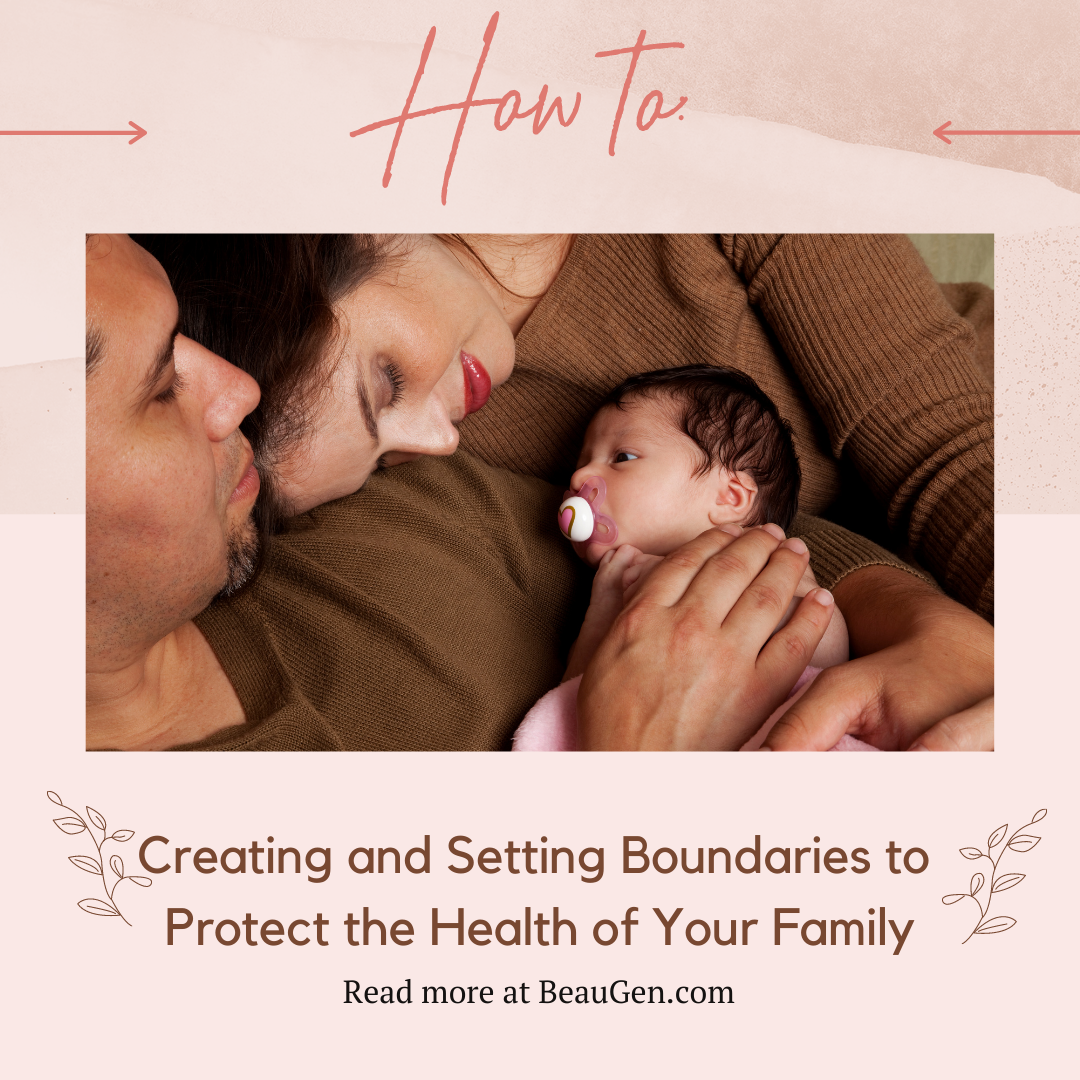Creating and Setting Boundaries to Protect the Health of Your Family
Mommy Care Team
How setting boundaries is part of a healthy self-care practice and can protect your family
There is so much pressure as a parent to do it all. From household cleaning and upkeep, to work, and maintaining relationships with family and friends, we take on a lot. Everything that we take on adds a bit of stress. If we don’t set boundaries, we risk saying yes to everything, setting ourselves up for failure. In this post we’ll take a closer look at how, where, and why you can set boundaries.
We mention setting boundaries in a previous post on the effects of mommy martyrdom which you can check out here.

What Do Boundaries Look Like
Depending on the scenario, boundaries can take a different form. When it comes to our personal workload in the home, it can be an agreement we make with ourselves or our partners to share the load, lessen the frequency of certain chores.
Many of us are now working from home. The lines between work and home life are more blurred than ever. The proximity to our work life can lead us to do more work than if we had clocked out and left our office. These boundaries can take different forms. In some instances it is setting a timer, or replacing clocking out with another behavior to protect our time with our families and allow us to recharge. In other cases, it may take conversation with your supervisor or coworkers.
Why Set Them?
Boundaries are a form of self-care. Setting a boundary is saying no to something that can lead you to becoming overwhelmed. They are signposts that keep us on the path to feeling accomplished and recharged at the same time.
Setting boundaries takes patience with ourselves. They take courage to set and effort to maintain. But if we take the time to establish boundaries, we are laying the groundwork for a healthier and happier life for ourselves and our families.
Examples of Boundaries from BeauGen Team Members:
Explaining to family members that you are not available for phone calls during the work day unless it is an emergency. This shows your family that even though you are home, it is in fact the work day.
Setting physical boundaries is also healthy. For example, making a family agreement not to bring work into the bedroom. Or creating physical distance from your phone or laptop when you are not working. In both of these examples, a clear delineation is created between work and family time, so that the two do not bleed into one another.
In our world we are almost constantly connected, especially when we have messaging apps like email and Slack on our cell phones. Turning off the notifications for these apps when you are outside of working hours is another great way to stay focused on family.

How to Set Boundaries
When you make the decision to establish the boundaries in your life, it can be difficult to know where to start. In this next section, we’ll try to help you determine where to start, but we highly recommend speaking with a professional. Counselors and therapists are equipped with tools and have insight that can find where boundaries would be the most impactful and provide you with the tools to set them.
Tune In(ward)
In order to determine where to set boundaries in your life, you need to be able to identify what causes stress. Every person has limits. These are thresholds, where we can take so much but no more than a certain amount. Stress happens when we reach these physical, emotional, and spiritual thresholds. This takes some introspection, time sitting with our thoughts and feelings. Stress equates to emotional noise, there is a cacophony of thoughts, feelings, and emotions all having simultaneous conversations. Inside these internal conversations where we find these thresholds.
There might be a few different stressors in your life.To be able to identify and set a boundary for each, we need to be able to key into these individual conversations to hear and understand each one.
New Feelings
When setting a boundary, you might notice new feelings emerging. You might feel guilty or experience fear. If these new feelings do arise, be gentle with yourself. It’s totally natural. Creating change, especially change as constructive as this will undoubtedly create new sensations and emotions.
Trying something new may take you a bit outside of your comfort zone. Traveling outside of your comfort zone naturally causes some discomfort. If setting certain boundaries is new for you and your family, it may take a bit for these boundaries to feel comfortable. Be gentle with yourself and remember why you are doing this.
Work In Progress
Once a boundary has been set, it requires maintenance. Keeping these boundaries that hold back stress and overwhelm demands that we regularly listen in to our thoughts, feelings, emotions, and desires. Every month, take stock of the boundaries that you have set up to identify which require maintenance.

Make Self-Care a Priority
Creating change takes time and effort. If you make self-care a priority, you set yourself up for success. It will take daily effort, consistent clear conversation either with yourself or others, and repetition.
Get Everyone in Your Home Onboard
This is helpful for a few different reasons. The first is that if the boundaries are understood, they will be more easily adopted and followed. If part of the family does not understand the reason for the boundary, they will be less likely to make the effort to go along with it.
The second reason why this is helpful is that you will have support when people from outside of the home or family question the boundary. Let’s talk about recent events, and setting the boundary of who can hold your baby. It's not too late to set this boundary if you haven’t already done so, but this is a big one to talk through with your husband, partner or parents. When you have family, friends, or neighbors coming over to your house, it will be natural for many of them to want to hold your baby. But, a newborn baby is fragile, and you might not be comfortable with anyone and everyone holding him or her. Setting a boundary might look like this: outside of the parents, only the people that live in your home and grandparents can hold the baby.
You might have a few people who are hurt or saddened by this boundary, but if everyone in your home is onboard, they can help you uphold it. If two people explain that this boundary was thoughtfully set and agreed upon, others will better understand and be able to respect the boundary too.
Who, What, Where, When, and Why
When talking through a boundary, it can be extremely helpful to use the 5 W’s. First, who does this boundary apply to? What is the boundary? Is there a physical boundary? Is this boundary only relevant for a certain time or during a certain time? And be very clear about why this boundary is important -- what effect or impact does it have on your family.
Let’s continue with the example of not allowing other people to hold your baby. In this case, it can be easier to focus on who you are okay with being near your newborn. The “what” is the action of holding your baby. Where you are might impact this boundary. For example, if you are in the comfort of your home, you might be comfortable with parents, grandparents, and siblings holding the baby. But when you are outside of the home, to make this boundary easier to keep, you might change this to limit baby holding to the parents only. When is also important to think through. A boundary like this will initially be set for the infancy of your child. As they grow older and establish more of an immune system, you can decide to broaden the who of this boundary. And lastly, we’ve already discussed the benefit of being clear in the reason for or why you are setting this boundary.
Be Prepared.
There will be some resistance. You will inevitably have to say no to people. It's never fun telling someone they can’t hold your baby. Asking people not to touch your baby is equally tough. But, these situations will arise, and you will, as a parent, inevitably have to inform people of your boundaries, and in some cases, even remind them.
The good news is that even if someone doesn’t agree with your boundary or thinks it goes a bit far, if you are kind and explain your reasoning, they should respect this boundary. Like just about everything else, saying no will become easier. Sometimes even practicing or playing through this situation in your mind before going out or having people over will better equip you and prepare you to say no.
Practice, Practice, Practice.
Setting boundaries takes work. We’ve walked through various steps and tips that can help you identify and create boundaries. Setting boundaries is like working a muscle in your body. Once you make the decision to set them, you need to keep exercising them to maintain them.
Setting a boundary is essentially creating a new habit, or breaking an existing one. It requires mindfulness and self-discipline once the boundary is established. This way, you continue to build upon the effort you have previously invested. Boundaries are healthy steps that your family is taking together. Letting one slide is like taking a giant step backwards.
